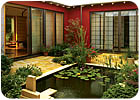
Architect Anthony Alofsin’s 2,600-square-foot home is designed around a 20- x 35-foot courtyard where he aimed to give it a modern, yet ancient feel in its Austin, TX, location.
Photo by Paul Bardagjy PhotographyWhen it came to building his own home in Austin, TX, architect Anthony Alofsin dedicated time to creating a unique design that reflected its natural environment, which included the use of local stone. The plan that took a year to construct was set to give a modern, yet ancient mood. “It feels Japanese and organic, as well as recalling a Texas vernacular,” said Alofsin.
The 2,600-square-foot home is designed around a 20- x 36-foot courtyard, where the indoor rooms are open to gardens and undisturbed landscape, but protected from the intense western sun. Alofsin strategically placed most of the stonework on the western side beneath overhanging roof eaves. “This was done to avoid any condition where water would run down the face of the stone and attract,” he said. “When water is kept off, the stone retains its color nicely.”
In keeping with the vernacular of Texas, Alofsin used stone from the Featherlite quarry, which is only 15 miles from the location of his home. “I wanted to use local materials because they are handsome, and the home is part of a local culture,” he said. “This decision also made the process relatively economical.”
The front of the home features three different limestones, including fociliferous shell stone, smooth limestone and rubble limestone. Smooth face and splitface Concrete Masonry Units (CMU) were combined to produce distinct patterns, according to the architect. At the end of the covered terrace on the back of the house is a wall of rubble white limestone created from a pattern that Alofsin drew. For the courtyard, flagstone from Arkansas was employed for part of the paving, whereas the surrounding edge of the pond is limestone. Leftover pieces of limestone were then used for the actual pond fountain.
Stone also continues into the interior. The floors consist of honed white limestone, which the architect noted provided contrast with the industrial ceramic countertops. The fireplace employs solid hand-pitched limestone blocks with smooth limestone at the bottom of the hearth, which has a bullnose molding. Hand-pitched ashlar encompasses the rest of the fireplace.
When accounting for the sizes of pieces used, Alofsin explained that the dimensions differed but all dimensions were controlled in the design process. “Everything was cut to modular sizes,” he said. “Stone used throughout the whole house was based on proportion, which allowed a harmonious effect even when the sizes varied.”
Alofsin concluded that the diversity of sizes all went together very adequately. “I’m very pleased with the results,” he said. “This is a very timely, serene place that people enjoy.”